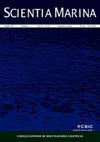用顺序提取法评估突尼斯南泻湖表层沉积物中的重金属污染风险
IF 0.9
4区 生物学
Q4 MARINE & FRESHWATER BIOLOGY
引用次数: 3
摘要
本研究调查了突尼斯东北部突尼斯南泻湖表层沉积物中重金属(Fe、Zn、Pb、Cu、Cr、Cd和Ni)的总浓度和化学形态。采用多种地球化学指标来评估潜在的环境风险。南泻湖是渔业、旅游业和水产养殖的宝贵区域资源。由于主要的水循环方向(从东到西),总金属浓度表现出显著的空间变化。Fe、Cr和Ni的化学形态表明,它们主要与残留部分(Fe 34.8%、Cr 37.4%和Ni 37.9%)有关,而Pb、Zn、Cu和Cd主要与非残留部分(不稳定部分Pb 89.4%、Zn 26.1%、Cu 71.8%和Cd 84.3%)有关。根据计算的全球污染因子,泻湖西侧的污染程度最高。此外,个别污染因素,铅,其次是锌和铜,造成污染的风险最高。这项研究表明,即使在疏浚之后,某些污染物的低浓度持续存在,也可能在某些物理化学条件下造成环境问题。本文章由计算机程序翻译,如有差异,请以英文原文为准。
Evaluation of heavy metal pollution risk in surface sediment of the South Lagoon of Tunis by a sequential extraction procedure
In this study, the total concentrations and chemical forms of heavy metals (Fe, Zn, Pb, Cu, Cr, Cd, and Ni) in surface sediments of the South Lagoon of Tunis located in northeast Tunisia were investigated. Multiple geochemical indices were applied to assess the potential environmental risks. The South Lagoon is a valuable regional resource for fisheries, tourism and aquaculture. Total metal concentrations exhibited significant spatial variation attributed to the principal water circulation direction (east to west). The chemical speciation of Fe, Cr and Ni shows that they were mostly related to the residual fraction (Fe 34.8%, Cr 37.4% and Ni 37.9%), while Pb, Zn, Cu, and Cd were mostly related to the non-residual fraction (labile fraction Pb 89.4%, Zn 26.1%, Cu 71.8% and Cd 84.3%). Pb, Zn, Cu and Cr are of high potential bioavailability. The highest pollution was found on the west side of the lagoon according to the calculated global contamination factors. Besides, individual contamination factors, Pb followed by Zn and Cu, posed the highest risk of contamination. This study shows that, even after dredging, the persistence of low concentrations of some contaminants may cause environmental problems in certain physico-chemical conditions.
求助全文
通过发布文献求助,成功后即可免费获取论文全文。
去求助
来源期刊

Scientia Marina
生物-海洋与淡水生物学
CiteScore
2.10
自引率
0.00%
发文量
21
审稿时长
6-12 weeks
期刊介绍:
Scientia Marina is the successor to Investigación Pesquera, a journal of marine sciences published since 1955 by the Institut de Ciències del Mar de Barcelona (CSIC). Scientia Marina is included in the Science Citation Index since 1998 and publishes original papers, reviews and comments concerning research in the following fields: Marine Biology and Ecology, Fisheries and Fisheries Ecology, Systematics, Faunistics and Marine Biogeography, Physical Oceanography, Chemical Oceanography, and Marine Geology. Emphasis is placed on articles of an interdisciplinary nature and of general interest.
 求助内容:
求助内容: 应助结果提醒方式:
应助结果提醒方式:


